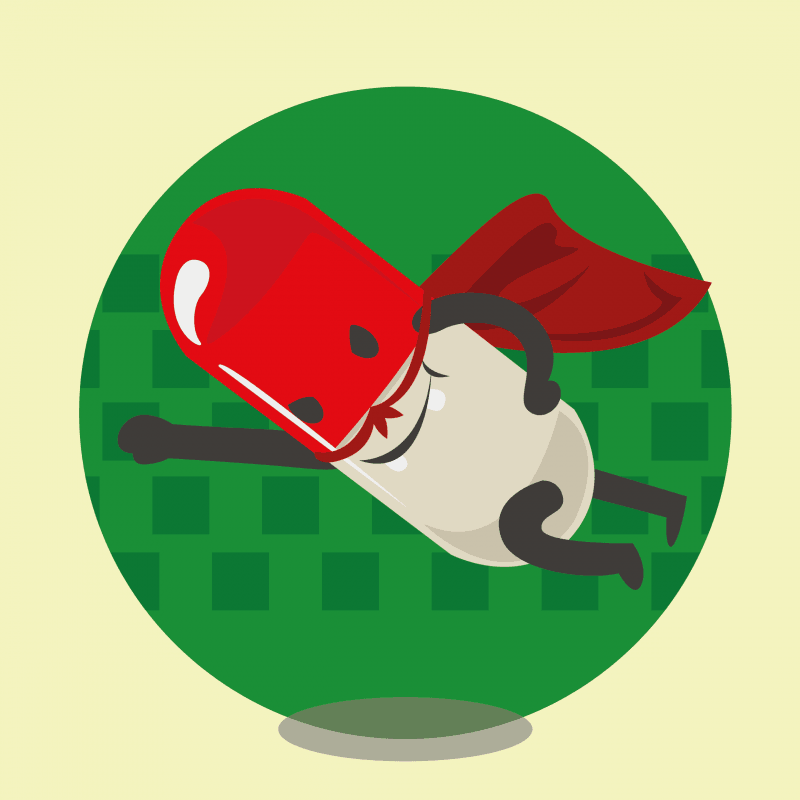
How often do you get to the end of the day feeling like you’ve accomplished a fraction of what you intended? If you’re like most of us, that is a common occurrence. What’s worse is when we look back and see the time we COULD have used…but didn’t.
As a medical student, I was often deflated by my inability to use my time effectively. A 5-minute YouTube “break” ended up lasting hours. Mental blocks would lead to checking my email or surfing the internet. During finals week, I would find any excuse – even cleaning my apartment – to avoid a topic I’d been struggling with.
What’s more disheartening was that my time-wasting was largely unconscious. Often, I would block my internet and email access. With programs like Freedom, even if you open a particular website (e.g., Gmail.com), it will show you a blank screen rather than the site.
This blank screen is a sobering reminder of the power of habit. I was shocked at how often I would open a tab to check my email. It was as if my unconscious actions were working against me.
But what if there were a better way? What if we could simply – and effectively – change our habits, so we get more done every day?
In this article, you will learn:
- How you can form NEW habits to counteract the time-wasting ones,
- A 15-minute exercise that could get you 15% better results,
- How MGH anesthesia residents improved their reading time by nearly 3x,
- The importance of strategy and tactics, and
- Much more
Table of Contents
Tactic: WOOP
There are vast amounts of digital ink spent on tactics for improving productivity. Despite that, I have found a few tactics that are:
- Time-efficient,
- Proven, and
- Durable
I’ve found that most of the time, the tactic will last for as long as my motivation does – which isn’t very long. Then I’m back in a spiral of internet-driven distractions that are driven by my subconscious. However, I’ve found at least one that has worked well.
One of the most effective tactics I’ve found has been a process called WOOP. Standing for Wish, Outcome, Obstacle, and Plan, WOOP results from decades of research on goal setting and achievement by Dr. Gabriele Oettingen.
I’ll describe it briefly. However, I highly recommend you listen to Dr. Oettingen here or here.
Most of us have heard about positive thinking. “Visualize it,” we’re told. However, there is strong evidence demonstrating that thinking positively by itself – which calms us by our mind acting as if we’ve accomplished our goals already – is DE-motivating. In other words, if I imagine myself scoring high on my USMLEs – or getting into the residency of my dreams – I will paradoxically work less to accomplish it.
Instead, try WOOP. First, identify an important goal, or wish.
Wish:
The wish should be something both essential and challenging – but attainable. For example, perhaps I want to do at least one Yousmle Online Course video every day while on a busy clinical rotation.
It can be challenging to study when spending so much time in the hospital. As such, doing one 40-50 minute video every day – and mastering the associated content through the included copy-and-paste Anki cards – is a good challenge.
Next, identify your desired outcome.
Outcome:
The outcome is essentially the best-case scenario if your wish were to come true. Imagine that outcome in detail, including the desired results and how you feel.
In other words, you might imagine: “I will master new content every day through the Course videos and improve my question interpretation. I will then feel much more confident in doing questions, my shelf scores would improve, and I’d impress my attendings/residents. On top of that, I’d build towards my goal of peaking on Step 2 CK so I can match into the best residency possible.”
All well and good, but don’t stop there. Next, identify the primary obstacle—that you can control– in your way.
Obstacle:
Up until this point, I’m feeling pretty good. Now, though, I have to face reality. Specifically, I need to identify the biggest INTERNAL obstacle standing in my way.
Internal obstacles are those things that I can control, rather than something external (e.g., my team makes me stay late in the hospital). For example, an internal obstacle may be my tendency to avoid uncomfortable/painful things. As we’ve discussed previously, much procrastination can be described as either:
- Avoiding unpleasant/uncomfortable things (e.g., doing QBank questions) and/or
- Having easy access to more pleasant activities (e.g., surfing the internet)
Possible internal obstacles might be:
- I am procrastinating because doing UWorld makes me feel anxious
- I am (checking my email) because I feel insecure when I don’t know something
Once you’ve identified your obstacle, you need to imagine it. Like with your Outcome above, be as vivid as possible. I might imagine coming home after a long day in the hospital and sitting down at my computer. I’d think about the tightness in my chest as I pondered opening UWorld. Then, I’d see myself click to go to my email as I sought an escape from my discomfort. The point here is to know how you react when encountering that obstacle.
Finally, come up with a plan to put all this together.
Plan:
Once you’ve identified your Wish, Outcome, and Obstacle, the final step is your Plan. This plan should be in the form of an “If…then…” statement. Additionally, it should be something that would
- Move you towards your goal, and
- Happen at the moment the obstacle arises
My plan might be something like this:
If… I feel anxious and avoid doing UWorld,
Then… I will remind myself, “doing uncomfortable things makes them better,” and open my QBank.
If… I feel insecure about not knowing something,
Then… I will remind myself, “my score improves more when I do hard things,” and start my Anki.
An even better tactic would be to include the “speed drill,” we discussed here as the Plan. Something like,
If… I feel anxious and avoid doing UWorld,
Then… I will do the “Oh F#@& to OK” Speed Drill and open my QBank.
(As a reminder, the Speed Drill is the fastest way to calm yourself down and focus – without needing a long cooldown like going to the gym).
Finally, Repeat Your Plan to Yourself
As a final step, repeat your “If…Then…” statement to yourself. I know it sounds silly, but this is part of how you can ingrain this into our unconscious. So often, it is our automatic, unconscious actions that derail us; to address that, we need to reprogram our unconsciousness. WOOP is a way to begin to do just that.
Create a WOOP in 15 Minutes or Less
You can do your WOOP here in less than 15 minutes.
There are also iOS and Android apps, which have the added benefit of saving your WOOPs for review and goal tracking.
WOOP Works (But We May Not Notice It)
There are two fascinating things when looking at the literature for WOOPs:
- It works, with effects lasting far longer than I expected, and
- Even when it works, people don’t seem to FEEL like it’s doing anything
In one study, stroke patients were randomized to get either WOOP or an information-only control. After only six 1-hour sessions, the WOOP group had more physical activity and lost more weight up to ONE YEAR LATER. I’m always impressed when a technique can have lasting effects without ongoing work. (Another is EMDR).
In a second one performed at my residency program at Harvard-MGH, residents in the ICU were randomized to either WOOP or SMART goal-setting. After all, the intervention was less than an hour – they are busy ICU residents. After a 30-minute WOOP vs. SMART goals (control) intervention, their studying was tracked for the month. Note that at MGH anesthesia, the ICU is the most time-consuming rotation; most residents feel they have minimal time to do outside reading. Despite these hurdles, the median study time for the WOOP group was nearly three times that of the control (4.3 hours vs. 1.5 hours, p=0.021).
In both studies – and my personal experience – the return on investment in WOOP is high. Rarely do you find techniques that you can do once and can have long-lasting results. Remember, the intervention group in the stroke patient study had better outcomes even a year after they did their original WOOPs!
If Your Nonconscious Actions Improve…Will You Know?
Perhaps the most fascinating finding is that while WOOP can have fast, durable effects, we may not be aware of it. In the MGH anesthesia resident study, there was no difference between baseline and final scores in self-reported satisfaction with reading habits, time management, or ability to achieve goals. In other words, despite studying more than they otherwise would have, residents’ satisfaction was unchanged from baseline.
That lack of satisfaction is fascinating but would fit with the idea that WOOP works on the subconscious. In other words, if WOOP helps us do more without us having to put in extra conscious effort, it may not be as satisfying as, say, a sweaty workout where we will ourselves to the finish line.
Strategy vs. Tactics: Both Are Necessary, Neither is Sufficient
Tactics like WOOP, where we change our unconscious actions and habits, are critical to getting more done in less time. That said, remember that tactics like WOOP are only half the battle. Doing MORE in a day won’t matter unless you do the RIGHT things.
For more ideas on strategy, read these articles:
- How to Study in Med School (and Keep Your Sanity)
- Motivation 101: Can You Learn To Love Med School? (Part 1)
- The Key to Success in Medical School (and Life)
- Slow is Fast: Why Cramming for the USMLE Takes Longer
Concluding Thoughts
So much of what we do is driven by our unconscious. Please think of how many times we pick up our phone without thinking. Or idly find ourselves checking our email. We self-sabotage all the time.
Thankfully, we have something that allows us to modify our automatic actions. WOOP is one of the most effective – and time-efficient – ways to improve our habits.
Remember, though, good tactics are necessary – but not sufficient – for mastery of the body. If you want to peak on your clerkships and Step 2 CK, your strategy must include mastery, retention, and applying vital medical concepts.
Everyone’s situation is different. Schedule a free consultation if you’d like help navigating the uncertain world of a pass-fail Step 1. You will take the first steps towards peaking on Step 2 CK – even if you haven’t taken your Step 1. Schedule your free consultation here.







